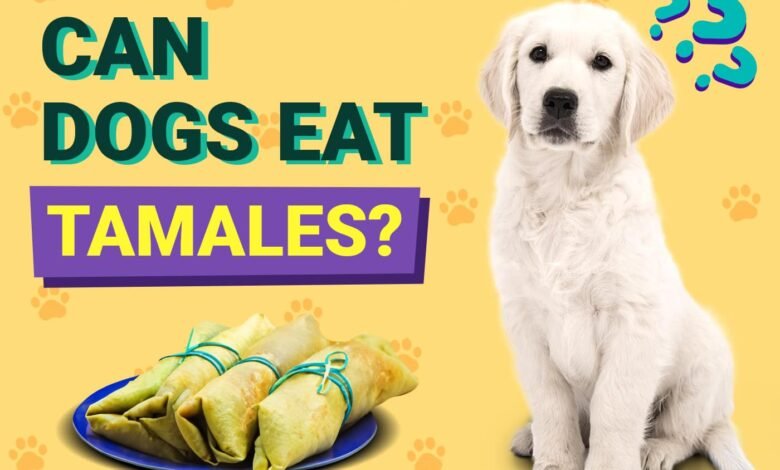Why Tamales Might Not Be Safe for Dogs

Let’s delve into the tantalizing world of tamale ingredients, where each component plays a vital role in creating the perfect bite! 🌽🧀🌶️
First up, we have masa—the cornerstone of every tamale. Crafted from corn dough, masa forms the sturdy yet tender outer layer that encases the delectable filling within.
Speaking of fillings, tamales offer a tantalizing array of options to suit every palate. From savory meats like tender pork or juicy chicken to creamy cheeses and hearty vegetables, the filling possibilities are endless.
But what truly elevates tamales to culinary perfection are the seasonings and spices. Picture the fiery heat of chili, the earthy warmth of cumin, the pungent aroma of garlic, and the subtle sweetness of onions—all coming together to create a symphony of flavors that dance across your taste buds with each mouthful.
Together, these common ingredients form the foundation of every tamale, creating a culinary masterpiece that has delighted taste buds for generations. So, whether you’re savoring a traditional recipe or putting your own spin on this beloved dish, let the magic of tamale ingredients transport you to a world of flavor and tradition. 🌟So let’s explore that-can dogs eat tamales?
Toxic Ingredients for Dogs
Understanding toxic ingredients for dogs is crucial for pet owners to ensure the safety and well-being of their furry companions. In this section, we will explore common toxic ingredients for dogs, including onions and garlic, spices, and cheese, and the potential health risks associated with their ingestion.
Onions and Garlic: Toxicity and Potential Health Risks
Onions and garlic belong to the Allium family and contain compounds that can be toxic to dogs if ingested in sufficient quantities. Here’s why onions and garlic pose health risks to dogs:
- Hemolytic Anemia: Onions and garlic contain substances that can cause damage to a dog’s red blood cells, leading to a condition known as hemolytic anemia. Symptoms may include weakness, lethargy, pale gums, and dark urine.
- Gastrointestinal Upset: Ingestion of onions and garlic can also cause gastrointestinal upset in dogs, including vomiting, diarrhea, abdominal pain, and loss of appetite.
Spices: Digestive Irritation and Allergic Reactions
While some spices are safe for dogs in small quantities, others can cause digestive irritation or allergic reactions. Here’s how spices can pose risks to dogs:
- Digestive Irritation: Spices such as chili powder, pepper, and nutmeg can irritate a dog’s digestive system, leading to vomiting, diarrhea, or abdominal discomfort.
- Allergic Reactions: Some dogs may be allergic to certain spices, resulting in symptoms such as itching, skin rashes, hives, or difficulty breathing.
Cheese: Lactose Intolerance in Many Dogs
While cheese is a popular treat for dogs, many dogs are lactose intolerant and may experience digestive issues after consuming dairy products. Here’s why cheese can pose risks to dogs:
- Lactose Intolerance: Most dogs lack the enzyme lactase, which is necessary for digesting lactose, the sugar found in milk and dairy products. As a result, ingestion of cheese and other dairy products can lead to gastrointestinal upset, including diarrhea, gas, and bloating.
By being aware of toxic ingredients for dogs such as onions and garlic, spices, and cheese, pet owners can take proactive measures to prevent their furry companions from ingesting harmful substances. It’s essential to carefully monitor what foods are offered to dogs and avoid feeding them anything that may pose risks to their health. If accidental ingestion occurs or if a dog exhibits any signs of toxicity or adverse reactions, prompt veterinary attention should be sought to ensure appropriate treatment and care.
Digestive Issues and High-Fat Content
Digestive issues and high-fat content in certain foods can pose significant health risks to dogs, impacting their overall well-being. In this section, we will explore the effects of high-fat content on dogs, the impact of masa on digestion, and the potential for gastrointestinal upset, including vomiting and diarrhea.
High Fat Content Leading to Pancreatitis and Obesity
Foods with high-fat content can contribute to various health issues in dogs, including pancreatitis and obesity. Here’s how high-fat content can affect dogs:
- Pancreatitis: Consumption of high-fat foods can trigger inflammation of the pancreas, leading to pancreatitis in dogs. This painful condition can cause symptoms such as abdominal pain, vomiting, diarrhea, and loss of appetite, and in severe cases, it may be life-threatening.
- Obesity: Regular consumption of high-fat foods can contribute to weight gain and obesity in dogs, increasing the risk of various health problems such as diabetes, joint issues, and cardiovascular disease.
Masa and Its Impact on Digestion
Masa, the corn dough used in tamales, may pose challenges for digestion in some dogs. Here’s how masa can impact digestion:
- Digestive Discomfort: The dense and starchy nature of masa may be difficult for some dogs to digest, leading to gastrointestinal discomfort such as bloating, gas, and abdominal pain.
- Potential for Constipation: Dogs that consume large amounts of masa may be at risk of developing constipation due to the lack of dietary fiber in corn dough.
Potential for Gastrointestinal Upset: Vomiting and Diarrhea
Consumption of foods with high-fat content or challenging-to-digest ingredients such as masa can result in gastrointestinal upset in dogs. Here’s how dogs may experience vomiting and diarrhea:
- Vomiting: Dogs may vomit after consuming high-fat foods or foods that are difficult to digest, as their bodies attempt to rid themselves of the irritants or indigestible substances.
- Diarrhea: High-fat foods or ingredients like masa can lead to diarrhea in dogs, characterized by loose or watery stools, increased frequency of bowel movements, and abdominal discomfort.
By understanding the potential digestive issues associated with high-fat content and ingredients like masa, pet owners can make informed decisions about their dog’s diet and take proactive measures to prevent gastrointestinal upset. It’s essential to prioritize feeding dogs a balanced and species-appropriate diet, avoiding foods that may trigger digestive problems or pose risks to their health. If digestive issues persist or worsen, consultation with a veterinarian is recommended to determine the underlying cause and appropriate treatment plan for the dog’s well-being.
Long-Term Health Risks
Long-term health risks associated with certain dietary practices can have a profound impact on a dog’s overall well-being and quality of life. In this section, we will explore the risks of obesity from high-calorie ingredients, the potential for chronic conditions like pancreatitis, and the risk of nutrient imbalance from inappropriate human food consumption.
Risk of Obesity from High-Calorie Ingredients
Feeding dogs foods with high-calorie ingredients can contribute to obesity, a significant health concern with long-term consequences. Here’s why high-calorie ingredients pose a risk of obesity in dogs:
- Excessive Caloric Intake: Foods rich in fats and carbohydrates, such as tamales or other high-calorie human foods, can lead to an imbalance between energy intake and expenditure, resulting in weight gain over time.
- Sedentary Lifestyle: Lack of regular exercise combined with a diet high in calories can exacerbate the risk of obesity in dogs, as they may not burn off excess energy consumed through food.
Potential for Chronic Conditions like Pancreatitis
Chronic conditions such as pancreatitis can develop as a result of dietary factors, including the consumption of high-fat foods like tamales. Here’s how pancreatitis can be linked to dietary habits in dogs:
- Inflammatory Response: Foods high in fat can trigger inflammation of the pancreas, leading to pancreatitis in susceptible dogs. Chronic pancreatitis can cause ongoing discomfort and may require long-term management to control symptoms and prevent complications.
- Recurrence Risk: Dogs that have experienced an episode of pancreatitis are at an increased risk of recurrence, especially if dietary habits remain unchanged and high-fat foods continue to be consumed.
Nutrient Imbalance from Inappropriate Human Food Consumption
Feeding dogs inappropriate human foods, such as tamales containing ingredients like onions, garlic, or excessive spices, can result in nutrient imbalances over time. Here’s how inappropriate human food consumption can lead to nutrient imbalance:
- Essential Nutrient Deficiencies: Dogs may miss out on essential nutrients required for optimal health and well-being if their diet is not properly balanced. Ingredients like onions, garlic, or spices may displace nutrient-rich foods in a dog’s diet, leading to deficiencies over time.
- Excess or Deficiency: Feeding dogs inappropriate human foods can disrupt the balance of nutrients in their diet, leading to excesses of some nutrients and deficiencies of others, which can contribute to long-term health issues.
By understanding the long-term health risks associated with certain dietary practices, pet owners can take proactive steps to ensure their dog’s diet is balanced, nutritious, and appropriate for their individual needs. Prioritizing a diet rich in high-quality ingredients, avoiding foods that may contribute to obesity or chronic conditions, and consulting with a veterinarian for personalized dietary recommendations are essential for promoting the long-term health and well-being of dogs.
Accidental Ingestion and Emergency Response
Accidental ingestion of tamales or other potentially harmful substances can occur, putting dogs at risk of toxicity or adverse reactions. In this section, we will explore the signs of toxicity or adverse reactions in dogs, immediate steps to take if a dog consumes tamales, and when to contact a veterinarian for emergency care.
Signs of Toxicity or Adverse Reactions
Recognizing the signs of toxicity or adverse reactions in dogs is crucial for prompt intervention and treatment. Here are common signs to watch for:
- Gastrointestinal Upset: Symptoms may include vomiting, diarrhea, abdominal pain, and loss of appetite.
- Lethargy: Dogs may appear unusually tired or lethargic, lacking their usual energy and enthusiasm.
- Difficulty Breathing: Respiratory distress, coughing, wheezing, or difficulty breathing may indicate a severe allergic reaction or respiratory issue.
- Neurological Symptoms: Seizures, tremors, disorientation, or collapse may occur in cases of severe toxicity.
Immediate Steps to Take if a Dog Consumes Tamales
If a dog consumes tamales or exhibits signs of toxicity or adverse reactions, immediate action is necessary. Here’s what to do:
- Remove Access to Tamales: Prevent further ingestion by removing any remaining tamales or tamale ingredients from the dog’s reach.
- Monitor Vital Signs: Check the dog’s vital signs, including heart rate, breathing rate, and temperature, to assess their condition.
- Contact Poison Control: Call your veterinarian or a pet poison control hotline for guidance on appropriate next steps based on the dog’s symptoms and the ingredients ingested.
When to Contact a Veterinarian for Emergency Care
In some cases, immediate veterinary attention is necessary to ensure the dog’s safety and well-being. Here’s when to contact a veterinarian for emergency care:
- Severe Symptoms: If a dog exhibits severe symptoms such as difficulty breathing, seizures, collapse, or loss of consciousness, seek emergency veterinary care immediately.
- Known Toxicity: If the dog has ingested known toxic ingredients such as onions, garlic, or excessive spices, contact a veterinarian for guidance on appropriate treatment.
- Persistent Symptoms: If symptoms persist or worsen over time, despite initial intervention, consult with a veterinarian for further evaluation and treatment.
By being vigilant and proactive in monitoring for signs of toxicity or adverse reactions and taking immediate steps to address them, pet owners can help ensure the safety and well-being of their furry companions. Quick action and prompt veterinary care can make a significant difference in the outcome for dogs who have ingested potentially harmful substances like tamales.
Safe Alternatives and Preventive Measures
Implementing safe alternatives and preventive measures is essential for protecting dogs from potential harm associated with consuming human foods like tamales. In this section, we will explore dog-friendly recipes inspired by tamales, tips for keeping human foods out of reach, and the importance of educating family members and guests about dog safety.
Dog-Friendly Recipes Inspired by Tamales
Creating dog-friendly recipes inspired by tamales allows pet owners to indulge their furry companions in tasty treats while ensuring their safety and well-being. Here are some dog-friendly tamale-inspired recipes to consider:
- Chicken and Sweet Potato Tamale Bites: Combine cooked chicken and mashed sweet potato, wrap in dog-safe masa dough, and bake until golden brown.
- Turkey and Vegetable Tamale Muffins: Mix lean ground turkey with diced vegetables, spoon into muffin cups lined with dog-friendly masa dough, and bake until cooked through.
- Fish and Rice Tamale Balls: Flaked cooked fish mixed with cooked brown rice and formed into balls, then coated in crushed dog-safe masa dough and baked until crispy.
Tips for Keeping Human Foods Out of Reach
Preventing access to human foods, including tamales, is essential for safeguarding dogs from potential hazards. Here are some tips for keeping human foods out of reach:
- Store Food Securely: Keep tamales and other human foods stored securely in sealed containers or high shelves to prevent dogs from accessing them.
- Use Pet Gates: Install pet gates or barriers to restrict access to areas where human foods are prepared or stored, such as kitchens or dining rooms.
- Trash Management: Dispose of food scraps and leftovers in secure trash bins with lids to prevent dogs from rummaging through garbage for potential snacks.
Educating Family Members and Guests about Dog Safety
Educating family members and guests about dog safety is crucial for preventing accidental ingestion of harmful foods. Here’s why dog safety education is important:
- Awareness of Risks: Inform family members and guests about the potential dangers of feeding human foods to dogs, including tamales, and encourage them to refrain from offering treats without permission.
- Clear Communication: Clearly communicate household rules and expectations regarding feeding practices to ensure consistency in managing the dog’s diet and health.
- Supervision: When hosting gatherings or events, designate a responsible adult to supervise interactions between dogs and guests to prevent unauthorized feeding and monitor for potential hazards.
By incorporating dog-friendly recipes inspired by tamales, implementing preventive measures to keep human foods out of reach, and educating family members and guests about dog safety, pet owners can create a safe and supportive environment for their furry companions. Prioritizing the well-being of dogs and taking proactive steps to prevent accidents and hazards are essential aspects of responsible pet ownership.




